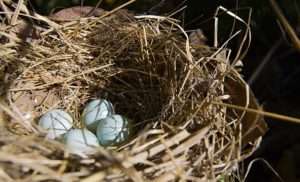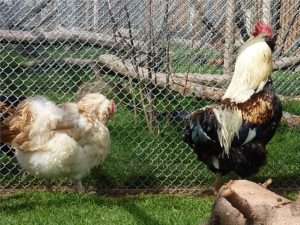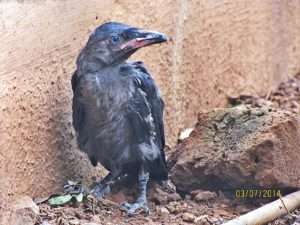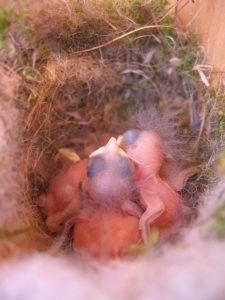 It’s nesting season here in the Northern hemisphere, and numerous species of bird from songbirds to waterfowl to raptors and many more are finding mates, staking out territories, building nests, and laying eggs that will produce the next generation of their species. Bird nests can be found just about anywhere; while some species prefer the quiet of deep forests or the relative safety of ocean cliffs, others are perfectly content to nest among human habitations, even using the eaves of houses for convenient nesting sites. Which means that not only do we get a chance to see these adorable little babies up close and personal, but it’s also the season where wildlife rehabbers start getting asked “I found a baby bird! What do I do?”
It’s nesting season here in the Northern hemisphere, and numerous species of bird from songbirds to waterfowl to raptors and many more are finding mates, staking out territories, building nests, and laying eggs that will produce the next generation of their species. Bird nests can be found just about anywhere; while some species prefer the quiet of deep forests or the relative safety of ocean cliffs, others are perfectly content to nest among human habitations, even using the eaves of houses for convenient nesting sites. Which means that not only do we get a chance to see these adorable little babies up close and personal, but it’s also the season where wildlife rehabbers start getting asked “I found a baby bird! What do I do?”
Myths and Facts
First things first: let’s dispel a couple of myths:
–If you touch a baby bird your smell will drive the parents away and they will abandon it even if you place it back in the nest.
Bird do, in fact, have a better sense of smell than was previously assumed. This doesn’t mean that the smell of humans will automatically drive them off, though. Keep in mind that birds that live close to us are already going to be used to our various scents. It’s even possible we may accidentally brush up against a nest hidden in a bush, leaving our aroma behind on the leaves and twigs, or even the nest itself.
Also, while birds may abandon a nest if they feel that the site has become too dangerous, a single encounter with a predator–human or otherwise–is not necessarily enough to drive them away. In fact, some birds will even seek out a place that a particular predatory species lives in, because other predators may avoid that area.
I am guessing that this myth popped up because parents wanted to keep their kids from messing with bird nests. While it’s definitely a good idea to keep your distance from nests as much as possible so as to avoid stressing out the occupants, it is not true that placing a baby bird back in a nest it’s fallen out of will automatically make the parents abandon it.
–Wild baby birds are as easy to care for as domestic pets, and anyone can do it!
First, let me define a few terms:
Domesticated animals are those that have been raised by humans for thousands of years, and in most cases have become a different species (or at least subspecies) than their wild counterparts.
Tamed animals are those that have been kept in captivity for a few generations, but are still essentially the same species as their wild counterparts; while tame animals may be more tolerant of humans, they still retain much of their wild behavior and need extra support and enrichment to thrive in captivity.
Wild animals were born in the wild, and largely live their lives independent of any human interference. While some individuals that live close to humans may be more tolerant of us, they are in no way domesticated. Wild animals taken into captivity by humans are still essentially wild and should be treated as such.
 Let’s look at some examples with birds. Domesticated birds like chickens and other poultry have been bred for many generations to be easy to handle, accustomed to humans, and we have all sorts of commercial feeds available specifically for their dietary needs. While poaching is still a major concern, tamed birds like parrots are ideally bred in captivity where they are handled by humans from a very early age, and both breeders and hobbyists have access to plenty of information on how to properly feed these birds. There are even veterinarians who specialize in captive birds and other exotic pets in private hands. In spite of all this knowledge and support, tamed bird are still much more difficult to care for properly than domestic poultry.
Let’s look at some examples with birds. Domesticated birds like chickens and other poultry have been bred for many generations to be easy to handle, accustomed to humans, and we have all sorts of commercial feeds available specifically for their dietary needs. While poaching is still a major concern, tamed birds like parrots are ideally bred in captivity where they are handled by humans from a very early age, and both breeders and hobbyists have access to plenty of information on how to properly feed these birds. There are even veterinarians who specialize in captive birds and other exotic pets in private hands. In spite of all this knowledge and support, tamed bird are still much more difficult to care for properly than domestic poultry.
Wild birds–like the ones nesting in the tree in your yard–will become stressed if taken into captivity. Professional wildlife rehabilitators minimize handling of the birds and other animals in their care not only to minimize stress, but to also avoid habituating them to humans and making the animals lose their fear of us. These animals also usually have very specific dietary needs that can’t be fulfilled by commercial pet foods or human foods. And even under the best of care, many of them don’t survive to be released.
Baby wild birds in particular walk a fine line between thriving and starvation. Almost everything most baby birds eat in the first few weeks of their life is insects, and if they don’t get enough of them they can become malnourished even to the point of death. So if you think it’s a great idea to try and feed that baby bird you found some chicken baby food or wet dog food, think again. Even if the bird survives to fledging, the early malnourishment they received may affect them for the rest of their life.
Moreover, most well-meaning people who try to raise baby birds themselves treat them like pets and handle them far too much. If the bird survives the stress of being poked, prodded, and bothered all the time and manages to be released, they may never be able to live a fully wild life because they’ve imprinted on humans too much.
If You’ve Found a Baby Bird…
Let’s say you’re out walking around and you see a baby bird on the ground in front of you. Your first instinct is likely to be to want to help it–which is great! But you don’t necessarily need to whisk it off to a rehab.
 First, take a good look at the baby bird. Is it covered in feathers rather than fluff? The tail and wing feathers might be a little short, but that’s okay! You’ve likely found a fledgling, who is supposed to be out of the nest. Fledglings aren’t great at flying just yet, so they spend a lot of time hopping around, flapping their wings, and figuring out how to get back off the ground. Don’t worry–their parents are nearby keeping an eye on them, even if you don’t see them. The longer you hang around, though, the longer the parents are going to have to wait before it’s safe to fly in to feed the fledgling. If the fledgling is somewhere very unsafe, like in the middle of a street, move it to somewhere safe nearby. Then go somewhere else so that the parents can continue to care for their young.
First, take a good look at the baby bird. Is it covered in feathers rather than fluff? The tail and wing feathers might be a little short, but that’s okay! You’ve likely found a fledgling, who is supposed to be out of the nest. Fledglings aren’t great at flying just yet, so they spend a lot of time hopping around, flapping their wings, and figuring out how to get back off the ground. Don’t worry–their parents are nearby keeping an eye on them, even if you don’t see them. The longer you hang around, though, the longer the parents are going to have to wait before it’s safe to fly in to feed the fledgling. If the fledgling is somewhere very unsafe, like in the middle of a street, move it to somewhere safe nearby. Then go somewhere else so that the parents can continue to care for their young.
What if you find a fledgling that’s obviously injured or ill? Call your nearest wildlife rehab to see what they say. They may tell you to keep an eye on it if possible, or bring it in if things seem especially serious.
 Now, if the baby bird you’ve found on the ground isn’t fully feathered, or is only covered in downy fluff, and especially if its eyes are still closed, that’s a nestling that needs help. The first thing to do is to try and find the nest it fell out of. Once you’ve located it, see if you can get the baby bird back in there; if so, the parents should go right back to caring for it.
Now, if the baby bird you’ve found on the ground isn’t fully feathered, or is only covered in downy fluff, and especially if its eyes are still closed, that’s a nestling that needs help. The first thing to do is to try and find the nest it fell out of. Once you’ve located it, see if you can get the baby bird back in there; if so, the parents should go right back to caring for it.
Can’t see the nest? Or can’t reach it? Get a plastic butter container, tupperware, or similar lightweight container. Line it with grass and other soft material (no human hair or yarn, as these can wrap around bird legs and cause serious injury.) Nail the container as high as you can in the tree nearest where you found the nestling. Place the bird in the container, and then get out of sight. If the parents are around they should feed both the young in the original nest and the container nest you created. If it’s been a few hours and there’s still no sign of the parents, then call your nearest wildlife rehab to ask what to do next.
When to Walk Away
If you do have to leave a baby bird where it is, while you may be worried about it, remember that the many baby birds that don’t survive to adulthood are crucial sources of food for other animals. After all, baby foxes, coyotes, bobcats, hawks, and other young wildlife need to eat, too; part of why many birds have so many young is because it’s inevitable some of them will end up as prey for other animals. While a sick or injured fledgling may seem in danger, remember that the parents are still around, and may be able to support the young bird until it’s in better condition.
It can be difficult for someone who cares deeply for nature to walk away from such a difficult situation where we feel we could intervene. Yet often the best thing we can do is let nature take its course, whatever it will be.

Hi! So we found a day old nestling and have been feeding it and taking care of it for a week now. Eyes open and growing rapidly. The closest rehab center is hours away. I cannot find info online what to do now.. it just says to contact a rehab center. What if there isn’t one? Do I just let him go? Thanks!
Hi there! I would recommend calling the nearest rehab and asking them for care advice if you don’t have the ability to take the nestling to them directly. They may have advice on how to make sure this little bird gets the best start possible in your care.